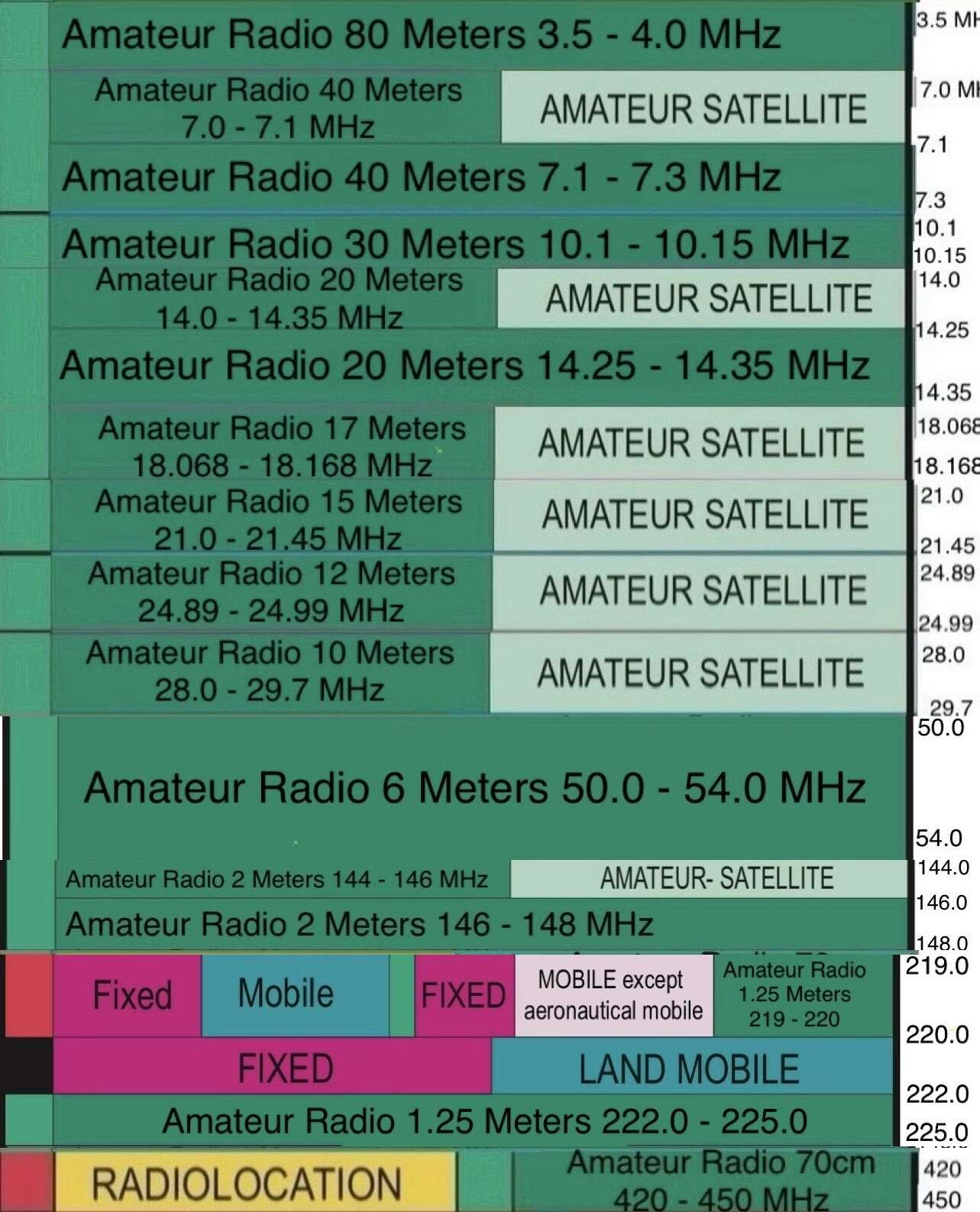Things To Know About Radio Frequencies
It is important to understand how radio frequencies are allocated for different use cases and coordinated to maximize effective use and reduce interference.
The radio spectrum is the radio frequency (RF) portion of the electromagnetic spectrum. Government agencies like the Federal Communications Commission (FCC) and Industry Canada are responsible for implementing and enforcing communications law and regulations.
Source: National Telecommunications and Information Administration
A band plan refers to a voluntary division of a band to avoid interference between incompatible modes. The International Amateur Radio Union (IARU) and regional organizations like the National Association for Amateur Radio (ARRL) in the USA and Radio Amateurs of Canada (RAC) coordinate the representation of amateur radio interests.
Source: ARRL Band Plan

This crude image includes slices from the Radio Spectrum Allocation visualization and labels with additional information from the Amateur Band Plan. Take special notice of the other allocations that share some of the bands that are allocated to Amateur Radio. Radiolocation shares the 70cm band from 420 - 450 MHz, and several fixed and mobile allocations share the 1.25 meter band from 219 - 220 MHz. Notice also how amateur satellite users share portions of several amateur bands with terrestrial users.
Related Topics:
I recommend keeping a copy of the Considerate Operator's Frequency Guide available near your station for quick reference. It shows frequencies generally recognized for certain modes or activities (all frequencies are in MHz).
Considerate Operator's Frequency Guide
Frequencies generally recognized for certain modes or activities
Source: http://www.arrl.org/considerate-operator
Nothing in the rules recognizes a net's, group's or any individual's special privilege to any specific frequency. Section 97.101(b) of the Rules states that "Each station licensee and each control operator must cooperate in selecting transmitting channels and in making the most effective use of the amateur service frequencies. No frequency will be assigned for the exclusive use of any station." No one "owns" a frequency.
It's good practice--and plain old common sense--for any operator, regardless of mode, to check to see if the frequency is in use prior to engaging operation. If you are there first, other operators should make an effort to protect you from interference to the extent possible, given that 100% interference-free operation is an unrealistic expectation in today's congested bands.
The following frequencies are generally recognized for certain modes or activities (all frequencies are in MHz) during normal conditions. These are not regulations and occasionally a high level of activity, such as during a period of emergency response, DXpedition or contest, may result in stations operating outside these frequency ranges.
Nothing in the rules recognizes a net's, group's or any individual's special privilege to any specific frequency. Section 97.101(b) of the Rules states that "Each station licensee and each control operator must cooperate in selecting transmitting channels and in making the most effective use of the amateur service frequencies. No frequency will be assigned for the exclusive use of any station." No one "owns" a frequency.
It's good practice "and plain old common sense" for any operator, regardless of mode, to check to see if the frequency is in use prior to engaging operation. If you are there first, other operators should make an effort to protect you from interference to the extent possible, given that 100% interference-free operation is an unrealistic expectation in today's congested bands.
Frequencies Modes/Activities
1.800-2.000 CW
1.800-1.810 Digital Modes
1.810 CW QRP calling frequency
1.843-2.000 SSB, SSTV and other wideband modes
1.910 SSB QRP
1.995-2.000 Experimental
1.999-2.000 Beacons
3.500-3.510 CW DX window
3.560 QRP CW calling frequency
3.570-3.600 RTTY/Data
3.585-3.600 Automatically controlled data stations
3.590 RTTY/Data DX
3.790-3.800 DX window
3.845 SSTV
3.885 AM calling frequency
3.985 QRP SSB calling frequency
7.030 QRP CW calling frequency
7.040 RTTY/Data DX
7.070-7.125 RTTY/Data
7.100-7.105 Automatically controlled data stations
7.171 SSTV
7.173 D-SSTV
7.285 QRP SSB calling frequency
7.290 AM calling frequency
10.130-10.140 RTTY/Data
10.140-10.150 Automatically controlled data stations
14.060 QRP CW calling frequency
14.070-14.095 RTTY/Data
14.095-14.0995 Automatically controlled data stations
14.100 IBP/NCDXF beacons
14.1005-14.112 Automatically controlled data stations
14.230 SSTV
14.233 D-SSTV
14.236 Digital Voice
14.285 QRP SSB calling frequency 14.286 AM calling frequency
18.100-18.105 RTTY/Data
18.105-18.110 Automatically controlled data stations
18.110 IBP/NCDXF beacons
18.162.5 Digital Voice
21.060 QRP CW calling frequency 21.070-21.110 RTTY/Data
21.090-21.100 Automatically controlled data stations
21.150 IBP/NCDXF beacons
21.340 SSTV
21.385 QRP SSB calling frequency
24.920-24.925 RTTY/Data
24.925-24.930 Automatically controlled data stations
24.930 IBP/NCDXF beacons
28.060 QRP CW calling frequency 28.070-28.120 RTTY/Data
28.120-28.189 Automatically controlled data stations
28.190-28.225 Beacons
28.200 IBP/NCDXF beacons
28.385 QRP SSB calling frequency 28.680 SSTV
29.000-29.200 AM
29.300-29.510 Satellite downlinks 29.520-29.580 Repeater inputs
29.600 FM simplex
29.620-29.680 Repeater outputs